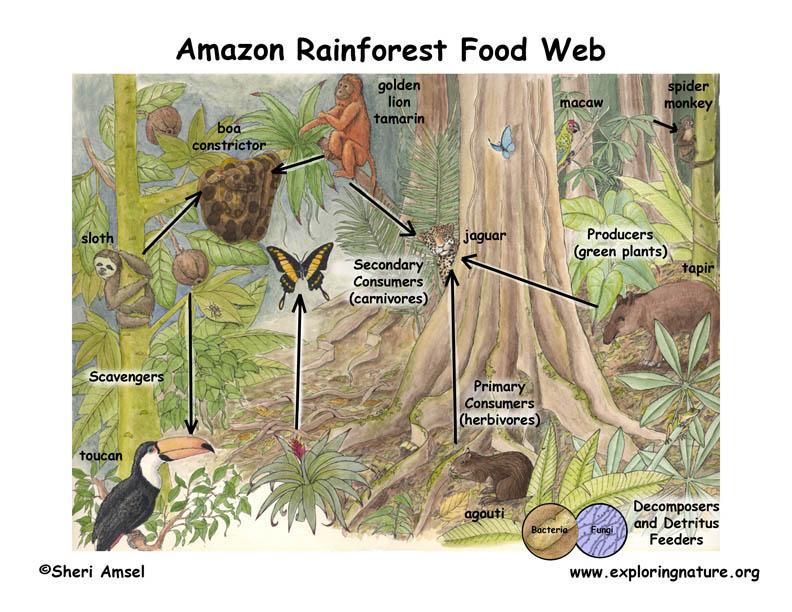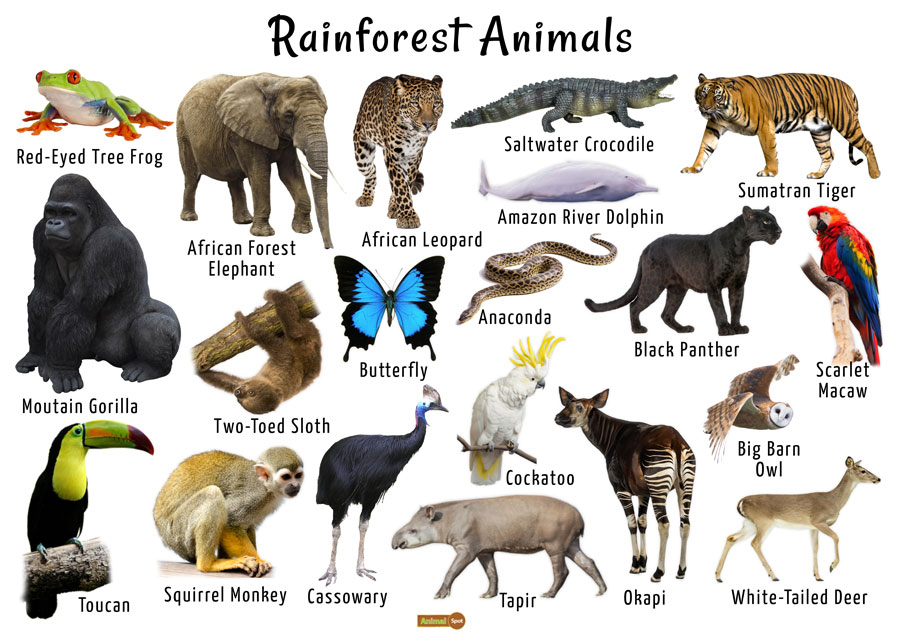Topic what is the rainforest ecosystem: Explore the heart of our planet"s biodiversity through the rainforest ecosystem, a vital, vibrant world teeming with life and crucial for global health.
Table of Content
- What are the different types of rainforests and where are they mostly located?
- Definition and Importance of Rainforests
- Characteristics of Rainforest Ecosystems
- Diversity of Life in Rainforests
- Layers of the Rainforest
- Climate and Location of Rainforests
- Role of Rainforests in Global Ecology
- YOUTUBE: Rainforests 101 - National Geographic
- Threats to Rainforests and Conservation Efforts
What are the different types of rainforests and where are they mostly located?
The world is home to two main types of rainforests: tropical rainforests and temperate rainforests.
- Tropical rainforests: These rainforests thrive in tropical regions, which are typically located near the equator where the climate is warm and humid throughout the year. Some of the most well-known tropical rainforests are the Amazon rainforest in South America, the Congo Basin rainforest in Central Africa, and the rainforests of Southeast Asia.
- Temperate rainforests: Unlike tropical rainforests, temperate rainforests can be found in more diverse locations, typically in coastal areas with mild climates. Examples of temperate rainforests are the Pacific Northwest rainforests of North America, including the coastal regions of Washington, Oregon, and British Columbia.
Both types of rainforests are incredibly biodiverse ecosystems, but their characteristics and species compositions differ due to variations in climate and geographical location.
READ MORE:
Definition and Importance of Rainforests
Rainforests are dense, warm, wet forests, teeming with life, covering a significant portion of Earth"s land surface. They are crucial for the planet"s health, acting as global lungs by absorbing carbon dioxide and producing oxygen. The biodiversity within rainforests is unparalleled, hosting millions of species, many of which are not found anywhere else on Earth. These ecosystems play key roles in regulating climate patterns, supporting water cycles, and providing livelihoods for many indigenous communities.
- Biodiversity Hotspots: Rainforests are home to more than half of the world"s plant and animal species.
- Climate Regulation: They help stabilize the world"s climate by storing large amounts of carbon and regulating global temperatures.
- Water Cycle: Rainforests contribute to the water cycle by releasing water vapor into the atmosphere, creating rainfall locally and in distant regions.
- Medicinal Resources: A significant portion of modern medicines derive from rainforest plants, highlighting their importance in healthcare.
- Cultural Importance: Indigenous communities depend on rainforests for their cultural, spiritual, and physical well-being.
Rainforests are essential for the survival of our planet, providing ecological services that benefit the entire globe. Their conservation is crucial for maintaining biodiversity, fighting climate change, and preserving the natural heritage for future generations.

Characteristics of Rainforest Ecosystems
Rainforest ecosystems are distinguished by their unique characteristics, which create a complex and interdependent environment supporting a vast array of life forms. These features include:
- High Biodiversity: Rainforests are renowned for their incredible diversity of species, including thousands of plants, animals, and insects that are not found anywhere else.
- Dense Canopy: A multi-layered canopy structure allows for different habitats within the same ecosystem, supporting a variety of life forms at different heights from the ground to the treetops.
- Constant Warmth and Humidity: The climate is consistently warm and humid throughout the year, with little variation in temperature, fostering an ideal environment for growth.
- Heavy Rainfall: Rainforests receive high levels of rainfall, often exceeding 2,000 mm annually, which is crucial for maintaining the wet and lush conditions.
- Poor Soil Fertility: Despite the rich biodiversity, the soil in rainforests is often poor in nutrients. The rapid decomposition and nutrient uptake by the dense vegetation lead to this paradox.
- Ecological Interdependence: The survival of species within rainforest ecosystems is deeply interconnected, with complex relationships between plants, animals, insects, and microorganisms.
These characteristics not only define the rainforest ecosystem but also underscore its importance in sustaining the ecological balance and providing essential services like carbon sequestration and habitat provision. Protecting these ecosystems is crucial for preserving biodiversity and ensuring the health of our planet.
Diversity of Life in Rainforests
The rainforest ecosystem is a thriving hub of biodiversity, housing an unparalleled variety of life across its numerous layers. This diversity includes:
- Vast Plant Species: Rainforests are home to over two-thirds of the world’s plant species, including towering trees, diverse undergrowth, and myriad epiphytes that live on the surfaces of other plants.
- Incredible Animal Diversity: They provide habitat for a multitude of animals, from large mammals like jaguars and gorillas to countless insects, reptiles, and amphibians.
- Unique Bird Species: Rainforests are critical for bird life, with species such as toucans, parrots, and various birds of paradise contributing to the ecosystem"s vibrancy.
- Abundance of Insects: The warm, moist conditions are perfect for insects of all kinds, making rainforests home to an astonishing array of insects, many of which are still undiscovered.
- Rich Aquatic Life: Rainforest rivers and streams are teeming with life, including fish, amphibians, and aquatic plants, all adapted to their specific environments.
This diversity is not just a testament to the complexity of rainforest ecosystems but also underpins their resilience and the ecosystem services they provide, such as pollination, seed dispersal, and carbon sequestration. The interdependence of species within rainforests highlights the importance of each organism in maintaining the health and stability of the ecosystem.

Layers of the Rainforest
The rainforest is a complex, biologically rich environment that is organized into distinct layers, each with its own unique ecosystem. Understanding these layers is crucial for comprehending the biodiversity and ecological dynamics of rainforests. These layers are:
- Emergent Layer: This is the topmost layer, characterized by the tallest trees that reach heights of up to 200 feet. These trees have large, well-developed crowns that emerge above the rest of the canopy, receiving the most sunlight and enduring high wind speeds and temperature fluctuations.
- Canopy Layer: Below the emergent layer, the canopy forms a dense, continuous layer of foliage around 100 feet above the ground. This layer is home to a majority of rainforest species, including birds, insects, and mammals, due to the abundance of food and shelter.
- Understory Layer: This layer receives limited sunlight, creating a relatively clear area filled with smaller trees and shrubs. It is characterized by plants with large leaves adapted to low light conditions. The understory is home to a variety of animals, including insects, reptiles, and predators, relying on the dense vegetation for cover.
- Forest Floor: The ground layer, or forest floor, receives less than 2% of the sunlight and is relatively clear of vegetation due to the low light conditions. It is composed of a thin layer of leaves, seeds, fruits, and branches that quickly decompose, contributing to the nutrient-rich, but shallow, soil. This layer supports fungi, insects, and decomposers that play a crucial role in nutrient cycling.
Each layer of the rainforest supports a unique set of organisms adapted to their specific environment, contributing to the incredible biodiversity seen in these ecosystems. The distinct stratification of the rainforest allows for the coexistence of a wide variety of plant and animal species, making it one of the most vital and dynamic habitats on Earth.
Climate and Location of Rainforests
Rainforests are located in the tropical regions of the world and are known for their lush vegetation, diverse wildlife, and unique climate conditions. These ecosystems are crucial for the health of our planet, providing oxygen, absorbing carbon dioxide, and housing a vast array of biodiversity. The climate and location of rainforests play a significant role in their ecological function and biodiversity:
- Tropical Rainforests: Located around the equator, tropical rainforests experience a warm climate with temperatures averaging between 20°C to 25°C (68°F to 77°F) throughout the year. These regions receive high annual rainfall, typically between 1750mm and 2000mm, distributed evenly throughout the year, contributing to the high humidity and moist conditions that support diverse plant and animal life.
- Location: Tropical rainforests are found in South and Central America, Western and Central Africa, Southeast Asia, and parts of Australia and the Pacific Islands. The Amazon Rainforest in South America is the largest, covering approximately 5.5 million square kilometers.
- Subtropical Rainforests: These rainforests are located further from the equator than their tropical counterparts. They experience a more varied climate with a distinct wet and dry season. Despite the variation, subtropical rainforests maintain high humidity levels and support a rich diversity of species, though not as extensive as tropical rainforests.
- Location: Subtropical rainforests can be found in parts of Asia, South America, Africa, and North America. They are often located at the margins of tropical rainforest regions or in coastal areas.
The climate in rainforest ecosystems is characterized by minimal temperature fluctuations and significant precipitation, creating an environment that supports the Earth"s most productive and biologically diverse terrestrial habitats. The strategic location of rainforests around the Earth"s equator and in subtropical regions ensures their role as critical components of the global climate system, influencing weather patterns and supporting life far beyond their boundaries.

Role of Rainforests in Global Ecology
Rainforests play a critical role in the global ecology, acting as vital components of the Earth"s environmental and climatic systems. Their influence extends far beyond their geographical boundaries, impacting global weather patterns, carbon cycles, and biodiversity. The key roles of rainforests in global ecology include:
- Carbon Sequestration: Rainforests absorb vast amounts of CO2 from the atmosphere, helping to mitigate climate change. The dense vegetation and abundant plant life act as carbon sinks, storing carbon that would otherwise contribute to greenhouse gas concentrations.
- Biodiversity Conservation: Hosting over half of the world’s plant and animal species, rainforests are hotspots of biodiversity. They provide habitat for countless species, including many that are endemic and critically endangered. This biodiversity is crucial for ecological stability, medical discoveries, and food security.
- Water Cycle Regulation: Rainforests play a key role in the global water cycle. Through the process of transpiration, trees release water vapor into the atmosphere, contributing to cloud formation and precipitation. This not only supports the lush vegetation of the forests themselves but also contributes to rainfall in distant agricultural regions.
- Climate Regulation: By influencing the water cycle and sequestering carbon, rainforests help regulate global climate patterns. They act as the Earth"s thermostat, helping to stabilize temperatures and weather patterns across the globe.
- Medicinal Resources: Rainforests are a source of numerous medicinal compounds, many of which are yet to be discovered. These ecosystems provide the raw materials for drugs that treat diseases and conditions worldwide, highlighting their importance to global health.
- Economic Benefits: Beyond their ecological roles, rainforests contribute significantly to the economy through tourism, agriculture, and the harvesting of sustainable resources. They provide livelihoods for millions of people around the globe.
The role of rainforests in global ecology is indispensable. They are foundational to the health of our planet, supporting life in innumerable ways. Protecting and conserving rainforests is not just about preserving their inherent beauty and biodiversity but is essential for maintaining the ecological balance and sustainability of Earth"s environment.
Rainforests 101 - National Geographic
Explore the breathtaking beauty and astonishing biodiversity of the enchanting rainforest in this mesmerizing video. Immerse yourself in the lush greenery, vibrant wildlife, and soothing sounds of nature\'s paradise.
Amazon Rainforest - Ecosystems
Embark on an extraordinary journey through the Amazon Rainforest, a true natural wonder that will leave you in awe. Discover the secrets hidden within this majestic ecosystem, from majestic waterfalls to rare animals, in this captivating video.
READ MORE:
Threats to Rainforests and Conservation Efforts
Rainforests, despite their critical importance to global ecology, face numerous threats that jeopardize their existence and the myriad forms of life they support. Addressing these threats requires concerted global conservation efforts. Here are the primary challenges rainforests face and the steps being taken to preserve them:
- Deforestation: The most significant threat to rainforests is deforestation, driven by logging, agricultural expansion, mining, and infrastructure development. This not only destroys habitat but also contributes to climate change through the release of stored carbon.
- Climate Change: Global warming poses a severe threat to rainforests by altering precipitation patterns and increasing the frequency of fires and droughts, which can lead to the loss of species and changes in forest structure and function.
- Illegal Logging and Poaching: Illegal activities, including logging and poaching, deplete rainforests of their valuable timber and wildlife, often driven by global demand for exotic pets, hardwood, and other forest products.
- Agricultural Expansion: The conversion of forest land to agriculture, particularly for commodities like palm oil, soy, and cattle ranching, is a major driver of deforestation, resulting in habitat loss and fragmentation.
To combat these threats, various conservation efforts are underway:
- Protected Areas: Establishing national parks and protected areas to safeguard critical habitats and biodiversity from development and exploitation.
- International Agreements: Global agreements like the Paris Agreement aim to mitigate climate change impacts, which indirectly benefits rainforests.
- Reforestation and Restoration: Programs focused on replanting trees and restoring degraded areas of the forest to revive biodiversity and ecological functions.
- Sustainable Practices: Promoting sustainable land use and forest management practices among local communities, industries, and governments to reduce the impact on rainforests.
- Community Involvement: Engaging indigenous peoples and local communities in conservation efforts, recognizing their traditional knowledge and rights to the land.
- Research and Education: Conducting scientific research to understand rainforest ecosystems better and educating the public on the importance of rainforests and how to protect them.
The threats to rainforests are complex and interconnected, but through global cooperation, innovative conservation strategies, and the commitment of communities and individuals, we can work towards preserving these irreplaceable ecosystems for future generations.










:max_bytes(150000):strip_icc()/497408077-56af61ff3df78cf772c3c309.jpg)

